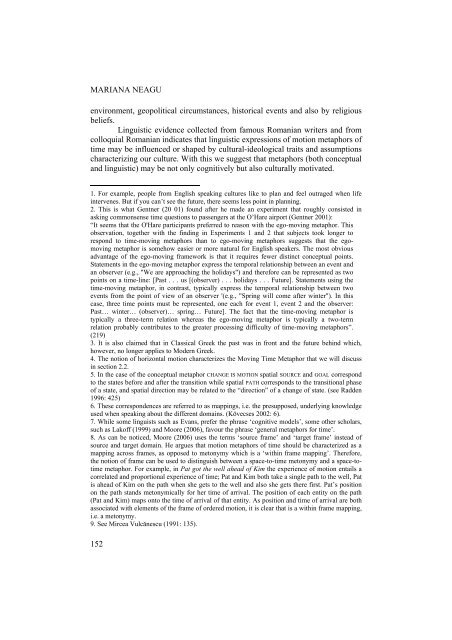culture, subculture and counterculture - Facultatea de Litere
culture, subculture and counterculture - Facultatea de Litere
culture, subculture and counterculture - Facultatea de Litere
Create successful ePaper yourself
Turn your PDF publications into a flip-book with our unique Google optimized e-Paper software.
MARIANA NEAGU<br />
environment, geopolitical circumstances, historical events <strong>and</strong> also by religious<br />
beliefs.<br />
Linguistic evi<strong>de</strong>nce collected from famous Romanian writers <strong>and</strong> from<br />
colloquial Romanian indicates that linguistic expressions of motion metaphors of<br />
time may be influenced or shaped by cultural-i<strong>de</strong>ological traits <strong>and</strong> assumptions<br />
characterizing our <strong>culture</strong>. With this we suggest that metaphors (both conceptual<br />
<strong>and</strong> linguistic) may be not only cognitively but also culturally motivated.<br />
1. For example, people from English speaking <strong>culture</strong>s like to plan <strong>and</strong> feel outraged when life<br />
intervenes. But if you can’t see the future, there seems less point in planning.<br />
2. This is what Gentner (20 01) found after he ma<strong>de</strong> an experiment that roughly consisted in<br />
asking commonsense time questions to passengers at the O’Hare airport (Gentner 2001):<br />
“It seems that the O'Hare participants preferred to reason with the ego-moving metaphor. This<br />
observation, together with the finding in Experiments 1 <strong>and</strong> 2 that subjects took longer to<br />
respond to time-moving metaphors than to ego-moving metaphors suggests that the egomoving<br />
metaphor is somehow easier or more natural for English speakers. The most obvious<br />
advantage of the ego-moving framework is that it requires fewer distinct conceptual points.<br />
Statements in the ego-moving metaphor express the temporal relationship between an event <strong>and</strong><br />
an observer (e.g., "We are approaching the holidays") <strong>and</strong> therefore can be represented as two<br />
points on a time-line: [Past . . . us [(observer) . . . holidays . . . Future]. Statements using the<br />
time-moving metaphor, in contrast, typically express the temporal relationship between two<br />
events from the point of view of an observer '(e.g., "Spring will come after winter"). In this<br />
case, three time points must be represented, one each for event 1, event 2 <strong>and</strong> the observer:<br />
Past… winter… (observer)… spring… Future]. The fact that the time-moving metaphor is<br />
typically a three-term relation whereas the ego-moving metaphor is typically a two-term<br />
relation probably contributes to the greater processing difficulty of time-moving metaphors”.<br />
(219)<br />
3. It is also claimed that in Classical Greek the past was in front <strong>and</strong> the future behind which,<br />
however, no longer applies to Mo<strong>de</strong>rn Greek.<br />
4. The notion of horizontal motion characterizes the Moving Time Metaphor that we will discuss<br />
in section 2.2.<br />
5. In the case of the conceptual metaphor CHANGE IS MOTION spatial SOURCE <strong>and</strong> GOAL correspond<br />
to the states before <strong>and</strong> after the transition while spatial PATH corresponds to the transitional phase<br />
of a state, <strong>and</strong> spatial direction may be related to the “direction” of a change of state. (see Rad<strong>de</strong>n<br />
1996: 425)<br />
6. These correspon<strong>de</strong>nces are referred to as mappings, i.e. the presupposed, un<strong>de</strong>rlying knowledge<br />
used when speaking about the different domains. (Kövecses 2002: 6).<br />
7. While some linguists such as Evans, prefer the phrase ‘cognitive mo<strong>de</strong>ls’, some other scholars,<br />
such as Lakoff (1999) <strong>and</strong> Moore (2006), favour the phrase ‘general metaphors for time’.<br />
8. As can be noticed, Moore (2006) uses the terms ‘source frame’ <strong>and</strong> ‘target frame’ instead of<br />
source <strong>and</strong> target domain. He argues that motion metaphors of time should be characterized as a<br />
mapping across frames, as opposed to metonymy which is a ‘within frame mapping’. Therefore,<br />
the notion of frame can be used to distinguish between a space-to-time metonymy <strong>and</strong> a space-totime<br />
metaphor. For example, in Pat got the well ahead of Kim the experience of motion entails a<br />
correlated <strong>and</strong> proportional experience of time; Pat <strong>and</strong> Kim both take a single path to the well, Pat<br />
is ahead of Kim on the path when she gets to the well <strong>and</strong> also she gets there first. Pat’s position<br />
on the path st<strong>and</strong>s metonymically for her time of arrival. The position of each entity on the path<br />
(Pat <strong>and</strong> Kim) maps onto the time of arrival of that entity. As position <strong>and</strong> time of arrival are both<br />
associated with elements of the frame of or<strong>de</strong>red motion, it is clear that is a within frame mapping,<br />
i.e. a metonymy.<br />
9. See Mircea Vulcănescu (1991: 135).<br />
152












